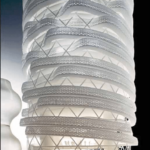
Lynn Fitzpatrick teaches studies in the departments of Architecture and Interior Architecture + Design in the Fay Jones School of Architecture and Design at the University of Arkansas. Her interest in lightweight architecture, particularly structural surfaces and long span building enclosures, influences her creative work in weaving. She investigates methods of inducing tension into textiles through material choice and weave structure. Recent work with students expands upon how high-tech fibers and textiles can be tensioned using structural elements found in architecture such as columns, tension cables, and structural frames. Lynn holds a Bachelor of Science in Design and Environmental Analysis from Cornell University and a Master of Architecture from Rice University.

On Weaving Architecture: The Potential of Lightweight Woven Structures
“The essentially structural principles that relate the work of building and weaving could form the basis of a new understanding between the architect and the inventive weaver. New uses of fabrics could result from a collaboration: and textiles, so often no more than an after-thought in planning, might take place again as a contributing thought.”
— Albers, Anni. “The Pliable Plane: Textiles in Architecture” in Perspecta, Vol.4 (Cambridge, MA: MIT Press, 1957) 40.
Historically the weaving of fiber was used to produce cloth to drape the body or cover an armature for nomadic shelter. It makes sense that weaving, in the context of architecture and design, might be deployed to constitute a building’s envelope, lining, or interior partitions. This seminar looks at weaving as the instigator of architecture starting with the primitive hut and culminating in technological advances in fibers and lightweight tensile systems that merge surface and structure. Weaving and knitting techniques and fashion-inspired prototypes will be introduced to demonstrate possibilities for textiles in the making of buildings and interiors. We will look at cutting-edge examples of how designers are using weaving techniques in large scale projects and probe questions that arise out of these exemplars. How can inherently pliable textiles translate to rigid membranes or surfaces? What speculative ventures could arise from a collaborative team of weaver and architect? Participants will experiment with creating small, column-like structures out of fiber.
Materials fee: None
